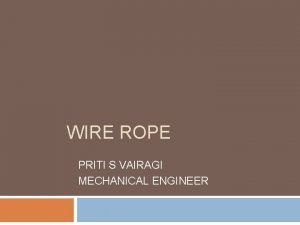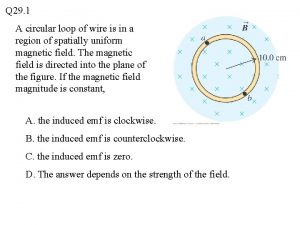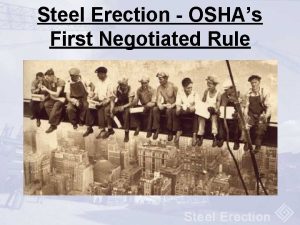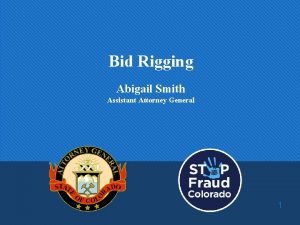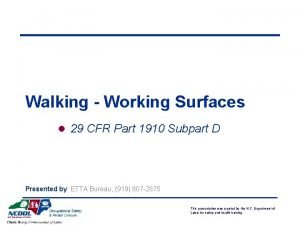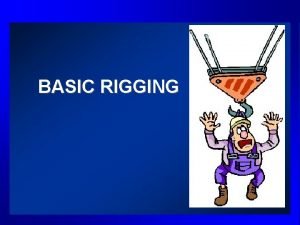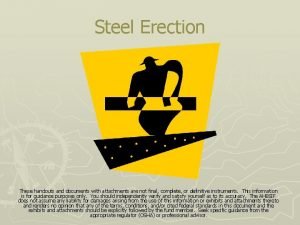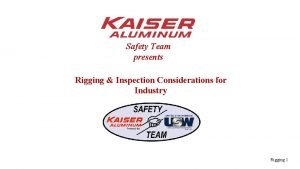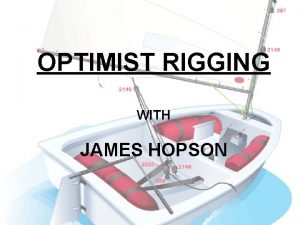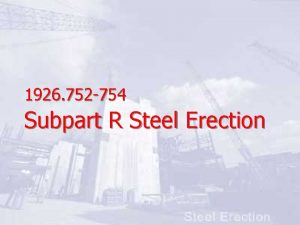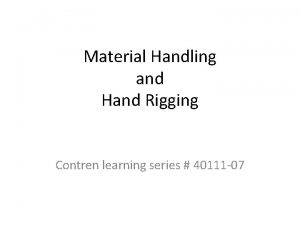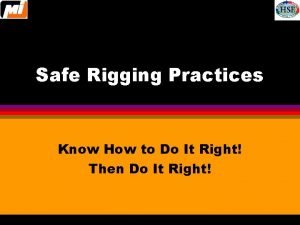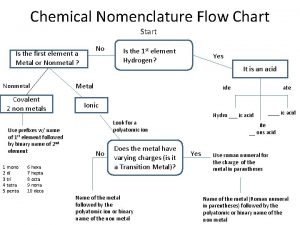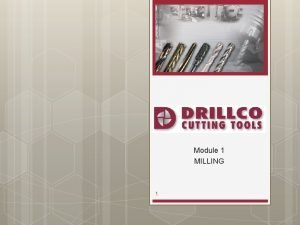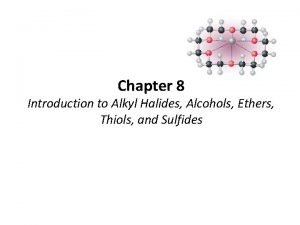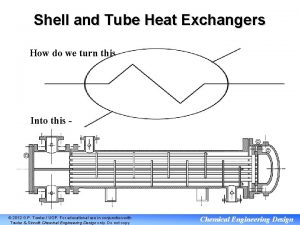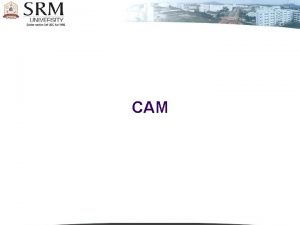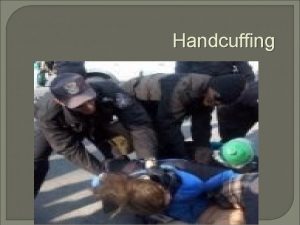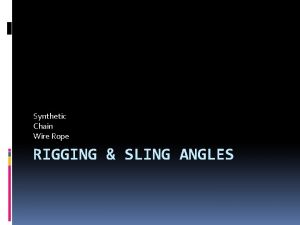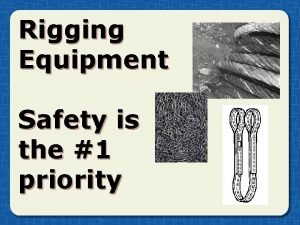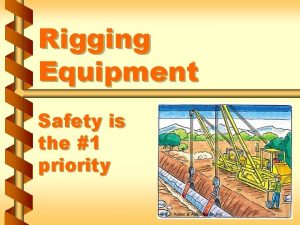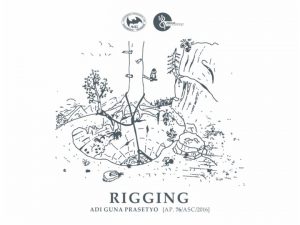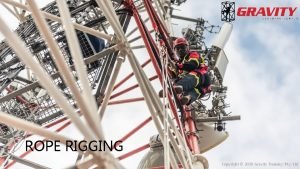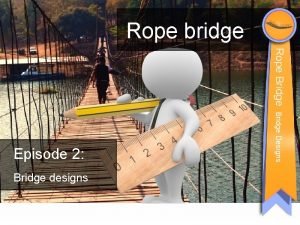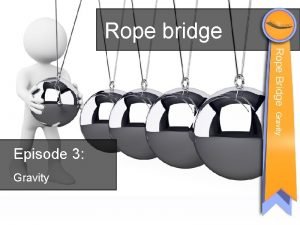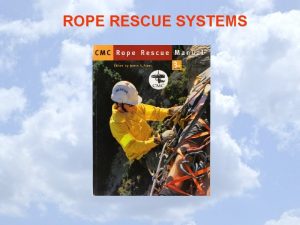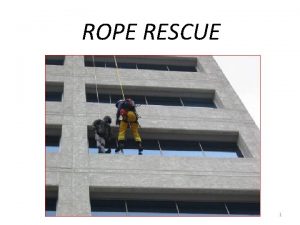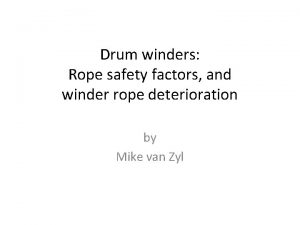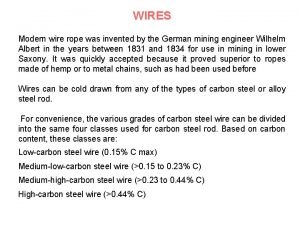Rigging Presentation 1 Wire Rope Nomenclature 2 A


























































































- Slides: 90

Rigging Presentation 1

Wire Rope Nomenclature 2

A wire rope is a Machine with many moving parts 3

The Core Fiber IWRC Strand 4

How to describe any wire rope A typical wire rope may be designated 6 X 25 FW PRF RLL XIP IWRC. This translates to: A 6 strand (6 X 25) of filler wire construction (FW). The grade of wire used is Extra Improved Plow Steel (XIP). The strands are preformed (PRF) in helical pattern before being laid Right lang (RLL) around an Independent Wire Rope Core (IWRC). 5

6 X 19 IWRC (Internal Wirerope Core) 6

7

Paint To Paint = 1 Lay 8

How a Wire Rope “Machine” Works 9

Equalizes Unequal Forces on The Rope as it Goes Over the Sheaves Right Lay Regular Lay Left Lay Regular Lay Right Lay Lang Lay 10

LUBRICATION Ropes and chains shall be regularly lubricated 11

BLOCK & TACKLE 12

Slings 13

Slings Choker Basket Straight Bridle 14

Straight Sling 15

Choker Sling 16

Basket Sling 17

Bridle Sling 18

Two legged Bridle Sling 19

Four legged Bridle Sling 20

Four legged Bridle Sling 21

22

SPLICES 23

Mechanical Splice 24

Hand Tucked Eye Splice 25

Hand Tucked Eye Splice 26

27

Mechanical Splice 28

29

30

ROPE INSPECTIONS 31

Always measure the diameter of any rope at its widest point - by turning the caliper on the rope 32

What’s wrong with this? 33

Broken Wires 34

How many broken wires? 35

Crushed 36

Close-up view 37

Kinking 38

Bird Caging 39

40

Slings and Attachments 41

OSHA STANDARDS 29 CFR 1926 CONSTRUCTION 42

1926. 251(a) Rigging equipment for material handling • (a) General. (1) Inspection of rigging equipment • (2) Rigging equipment shall not be loaded in excess of its recommended safe working load • (3) Rigging equipment, when not in use, shall be removed • (4) Marking of special custom design grabs, hooks, clamps, or other lifting accessories, for such units as modular panels, prefabricated structures and similar materials, shall be marked to indicate the safe working loads and shall be proof-tested prior to use to 125 percent of their rated load. 43

1926. 251(a) Rigging equipment for material handling • (5) "Scope. " – Applies to slings used in conjunction with other material handling equipment for the movement of material by hoisting, in employment's covered by this part. – Types of slings covered are those made from alloy steel chain, wire rope, metal mesh, natural or synthetic fiber rope (conventional three strand construction), and synthetic web (nylon, polyester, and polypropylene). • (6) "Inspections. " – Each day before being used, – Additional inspections where service conditions warrant. – Damaged or defective slings shall be immediately removed from service. 44

1926. 251(b) Alloy steel chains. (1) Welded alloy steel chain slings shall have permanently affixed durable identification stating size, grade, rated capacity, and sling manufacturer. 45

1926. 251(b) Alloy steel chains. (2) Hooks, rings, oblong links, pear-shaped links, welded or mechanical coupling links, or other attachments, when used with alloy steel chains, shall have a rated capacity at least equal to that of the chain. 46

• 1926. 251(b) Alloy steel chains. – (b)(3) Job or shop hooks and links, or makeshift fasteners, formed from bolts, rods, etc. , or other such attachments, shall not be used. 47

Alloy Steel Chain (b)(4) Rated capacity (working load limit) for alloy steel chain slings shall conform to the values shown in Table H-1. 48

Cracked, Pitted & Non-alloy Repair Link (b)(5) Whenever wear at any point of any chain link exceeds that shown in Table H-2, the assembly shall be removed from service. 49

Legal Repair Link 50

Illegal Repair Link Doesn’t have design load Strength - Malleability 51

Sling shackle 52

53

54

55

56

57

1926. 251(b) Rigging equipment for material handling • (b)(6) "Inspections. " – (i) In addition to the inspection required by other paragraphs of this section, a thorough periodic inspection of alloy steel chain slings in use shall be made on a regular basis, to be determined on the basis of • • (A) frequency of sling use; (B) severity of service conditions; (C) nature of lifts being made; and (D) experience gained on the service life of slings used in similar circumstances. Such inspections shall in no event be at intervals greater than once every 12 months. e Ropctions e Insp • (b)(6)(ii) The employer shall make and maintain a record of the most recent month in which each alloy steel chain sling was thoroughly inspected, and shall make such record available for examination. 58

1926. 251(c) Rigging equipment for material handling • (c) Wire rope. – Use tables H-3 - H-4 Rated Capacities For Single Leg Slings - to determine the safe working loads of various sizes and classifications of improved plow steel wire rope and wire rope slings with various types of terminals. 59

1926. 251(c) Rigging equipment for material handling • (c)(2) Protruding ends of strands in splices on slings and bridles shall be covered or blunted. • (c)(3) Wire rope shall not be secured by knots, except on haul back lines on scrapers. 60

1926. 251(c) Rigging equipment for material handling • • • (c)(4) The following limitations shall apply to the use of wire rope: – (i) Eye splice – (ii)Eye splices in the ends of wires and for endless rope slings continuous piece without knot or splice. – (iii) Eyes in wire rope slings – (iv) When wire rope shows signs of excessive wear, corrosion, or defect. (5) When U-bolt wire rope clips are used to form eyes, – (i) When used for eye splices, the U-bolt shall be applied so that the "U" section is in contact with the dead end of the rope. (c)(6) Slings shall not be shortened with knots or bolts or other makeshift devices. 61

Internal Color Code String To ID. MFG. 62

Wire Rope Clips 63

64

Sand cast clip 65

Fist Grip 66

Double Saddle Wire Rope Clip 67

1926. 251(e) Rigging equipment for material handling • (e) Synthetic webbing (nylon, polyester, and polypropylene). • (1) The employer shall have each synthetic web sling marked or coded to show: – (i) Name or trademark of manufacturer. – (ii) Rated capacities for the type of hitch. – (iii) Type of material. 68

1926. 251(e) Rigging equipment for material handling • (2) Rated capacity shall not be exceeded. • (3) "Webbing. " Synthetic webbing shall be of uniform thickness and width and selvage edges shall not be split from the webbing's width. • (4) "Fittings. " Fittings shall be: – (i) Of a minimum breaking strength equal to that of the sling; and – (ii) Free of all sharp edges that could in any way damage the webbing. 69

1926. 251(e) Rigging equipment for material handling • (5) "Attachment of end fittings to webbing and formation of eyes. ” Stitching shall be the only method used to attach end fittings to webbing and to form eyes. The thread shall be in an even pattern and contain a sufficient number of stitches to develop the full breaking strength of the sling. 70

1926. 251(e) Rigging equipment for material handling • (6) "Environmental conditions. " When synthetic web slings are used, the following precautions shall be taken: – (i) Nylon web slings shall not be used where fumes, vapors, sprays, mists or liquids of acids or phenolics are present. – (ii) Polyester and polypropylene web slings shall not be used where fumes, vapors, sprays, mists or liquids of caustics are present. – (iii) Web slings with aluminum fittings shall not be used where fumes, vapors, sprays, mists or liquids of caustics are present. 71

1926. 251(e) Rigging equipment for material handling • (7) "Safe operating temperatures. " Synthetic web slings of polyester and nylon shall not be used at temperatures in excess of 180 deg. F (82. 2 deg. C). Polypropylene web slings shall not be used at temperatures in excess of 200 deg. F (93. 33 deg. C). 72

1926. 251(e) Rigging equipment for material handling • (8) "Removal from service. " Synthetic web slings shall be immediately removed from service if any of the following conditions are present: – – – (i) Acid or caustic burns; (ii) Melting or charring of any part of the sling surface; (iii) Snags, punctures, tears or cuts; (iv) Broken or worn stitches; or (v) Distortion of fittings. 73

All rigging equipment must be inspected on a regular basis 74

Check handle of metal mesh sling for rated load capacity 75

Most damage is easy to see 76

Heat Damage 77

78

Do Not use for lifting Doesn’t have design load Strength Malleability 79

Melted Link 80

81

Deformed hook 82

83

Positive Latching Hook Per 550 (G) 84

85

Wedge Socket (Terminator) 86

87

Web connector with spool 88

89

90
 Wire rope nomenclature
Wire rope nomenclature Wire rope nomenclature
Wire rope nomenclature Steel bar for prestressed concrete
Steel bar for prestressed concrete Seismic cable clamps manufacturer
Seismic cable clamps manufacturer Wire rope net house
Wire rope net house Why do magnets repel
Why do magnets repel A flexible loop of wire lies in a uniform magnetic field
A flexible loop of wire lies in a uniform magnetic field Examples of bid rigging
Examples of bid rigging Safety cable holes in columns
Safety cable holes in columns Al smith rigging
Al smith rigging Rigging an experiment meaning
Rigging an experiment meaning Bid rigging
Bid rigging Riham toulan
Riham toulan Softeners for rigging
Softeners for rigging Bid rigging vs price fixing
Bid rigging vs price fixing Fall protection osha 1910
Fall protection osha 1910 Hook throat opening
Hook throat opening Christmas treeing rigging
Christmas treeing rigging Bid rigging example
Bid rigging example Rigging angles
Rigging angles Optimist tuning guide
Optimist tuning guide During steel floor assembly shear connectors
During steel floor assembly shear connectors Irata training
Irata training Contren learning series
Contren learning series Safe rigging practices and procedures
Safe rigging practices and procedures 5cm labor
5cm labor 4 maneuvers of leopold
4 maneuvers of leopold Alloy nomenclature
Alloy nomenclature Np covalent compound name
Np covalent compound name Functional isomers of carboxylic acids
Functional isomers of carboxylic acids Nomenclature
Nomenclature Type 3 nomenclature
Type 3 nomenclature Chemistry flow chart
Chemistry flow chart Binomial nomenclature for cat
Binomial nomenclature for cat Nomenclature of enzymes
Nomenclature of enzymes Classification of cam and follower
Classification of cam and follower Importance of microbes
Importance of microbes End mill nomenclature
End mill nomenclature Xxx police report
Xxx police report Gmdn
Gmdn Alcohols nomenclature
Alcohols nomenclature Priority of functional groups
Priority of functional groups Binomial nomenclature practice worksheet
Binomial nomenclature practice worksheet Inorganic nomenclature flow chart
Inorganic nomenclature flow chart Alcohols nomenclature
Alcohols nomenclature Telecanthus
Telecanthus Nomenclature
Nomenclature Cessna airfoil
Cessna airfoil Correction
Correction Bcd addition of 184 and 576
Bcd addition of 184 and 576 Properties of alkyl halides
Properties of alkyl halides Grouping objects or information based on similarities
Grouping objects or information based on similarities Duty of heat exchanger
Duty of heat exchanger Alcohols nomenclature
Alcohols nomenclature Triple bond nomenclature
Triple bond nomenclature Pcc with aldehyde
Pcc with aldehyde Elastic energy
Elastic energy Cyanohydrine
Cyanohydrine Spring nomenclature
Spring nomenclature Acid and base nomenclature
Acid and base nomenclature Order of classification of organisms
Order of classification of organisms Outline the binomial system of nomenclature
Outline the binomial system of nomenclature Cam nomenclature
Cam nomenclature Tourniquet nomenclature
Tourniquet nomenclature Inorganic nomenclature
Inorganic nomenclature How to name esters
How to name esters C-c-c-c-c chemistry
C-c-c-c-c chemistry Common polyatomic ions
Common polyatomic ions Standing handcuffing techniques
Standing handcuffing techniques 18-1 finding order in diversity
18-1 finding order in diversity Down milling vs up milling
Down milling vs up milling Honeywell gas valve nomenclature
Honeywell gas valve nomenclature Fisher race to weiner
Fisher race to weiner Nomenclature of ether
Nomenclature of ether Nucleotide nomenclature
Nucleotide nomenclature Nomenclature revit
Nomenclature revit Heterocyclic compounds nomenclature
Heterocyclic compounds nomenclature Nomenclature of binary ionic compounds
Nomenclature of binary ionic compounds Palindrome and mirror repeat
Palindrome and mirror repeat Binomial nomenclature
Binomial nomenclature Rules of binomial nomenclature
Rules of binomial nomenclature General chemistry nomenclature
General chemistry nomenclature Blood transfusion groups
Blood transfusion groups Nomenclature of ethers
Nomenclature of ethers Taxonomic hierarchy of lion
Taxonomic hierarchy of lion Saturated hydrocarbon
Saturated hydrocarbon Nomenclature of ether
Nomenclature of ether Thioether
Thioether Nomenclature rpps
Nomenclature rpps Ionic nomenclature
Ionic nomenclature Computer sys digital: an/pyq-10(c)
Computer sys digital: an/pyq-10(c)

